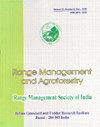有潜力的玉米(Zea mays L.)复合材料饲料产量和品质特征的遗传差异研究
IF 0.8
4区 农林科学
Q3 AGRONOMY
引用次数: 0
摘要
本研究的目的是利用基于主成分分析(PCA)的形态学-农艺学数据评估 27 个玉米品种的遗传变异程度,并利用分层聚类分析测量这些基因型之间的遗传距离。27 个复合品种采用随机完全区组设计,三次重复,种植两年。对实验材料的 15 个形态特征进行了评估。青饲料产量取决于其他各种性状,如株高、叶片数、叶片长度和饲料质量性状,如粗蛋白、酸性洗涤纤维和中性洗涤纤维。这项研究表明,青饲料产量与上述各种性状呈正相关。叶片数和穗高之间(0.723)以及粗蛋白和干物质消化率之间(0.823)存在很高的正相关性。然而,粗蛋白与酸性洗涤纤维(-0.739)和中性洗涤纤维(-0.678)呈显著的负相关。有五个主成分的特征值超过一个,对基因型间变异的贡献率为 75%。主成分贡献了 125.1%,其次是主成分贡献了 19.9%,主成分贡献了 12.5%,主成分贡献了 9.7%,主成分贡献了 7.8%。斯克里图显示,2345 个实验材料可分为 5 个聚类。第 5 聚类下的基因型可用于提高青饲料产量。第 1 聚类的最小聚类内距离为 48.008,第 2 和第 5 聚类之间的最大聚类间距离为 259.45。所获得的不同群组可用于培育具有不同特征的近交系,这些近交系可用于各种玉米育种计划。本文章由计算机程序翻译,如有差异,请以英文原文为准。
Genetic divergence studies of fodder yield and quality attributing characteristics in promising maize (Zea mays L.)composites
The objective of the current study was to assess the extent of genetic variation among twenty-seven maize varieties using morpho-agronomic data based on Principal Component Analysis (PCA) and to measure the genetic distance among these genotypes using hierarchical cluster analysis. Twenty-seven composites were grown in a randomised complete block design with three replications for two years. The experimental material was assessed for 15 morpho-agronomic traits. Green fodder yield depends on various other traits such as plant height, number of leaves, leaf length and fodder quality traits such as crude protein, acid detergent fibre and neutral detergent fibre. This study showed a positive correlation of green fodder yield with various such traits. A very high positive correlation was noticed between number of leaves and ear height (0.723) and between crude protein and dry matter digestibility (0.823). However, crude protein showed a significant in vitronegative correlation with acid detergent fibre (-0.739) and neutral detergent fibre (-0.678). Five principal components had more than one eigen value, contributing 75% variability among genotypes. PC contributes 125.1% followed by PC with 19.9%, PC with 12.5%, PC with 9.7% and PC with 7.8%. The scree plot revealed 2345that the experimental material could be divided into five clusters. The genotypes under cluster five could be used to improve green fodder yield. The minimum intra-cluster distance observed for cluster 1 was 48.008, and the maximum inter-cluster distance observed between clusters 2 and 5 was 259.45. The different groups obtained could be useful for deriving the inbred lines with diverse features, which could be used in various maize breeding programmes.
求助全文
通过发布文献求助,成功后即可免费获取论文全文。
去求助
来源期刊

Range Management and Agroforestry
AGRONOMY-
CiteScore
1.50
自引率
62.50%
发文量
25
审稿时长
>12 weeks
期刊介绍:
The Society has been established with the following objectives:
1. To advance the cause of research activity in all aspects of rangelands and to encourage and promote the studies on rangeland, wasteland ecosystems and agroforestry.
2. To provide facilities for seminars and conferences to rangeland researchers, development workers and farmers and to encourage close cooperation with organizations having related aims and interests.
3. To disseminate the knowledge of scientific agriculture and technology for forage and rangeland production, improvement and management.
 求助内容:
求助内容: 应助结果提醒方式:
应助结果提醒方式:


